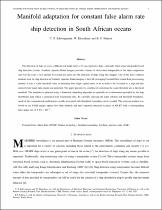 ResearchSpace
ResearchSpace
Manifold adaptation for constant false alarm rate ship detection in South African oceans
JavaScript is disabled for your browser. Some features of this site may not work without it.
- ResearchSpace
- →
- Research Publications/Outputs
- →
- Journal Articles
- →
- View Item
| dc.contributor.author |
Schwegmann, CP

|
|
| dc.contributor.author |
Kleynhans, W

|
|
| dc.contributor.author |
Salmon, BP

|
|
| dc.date.accessioned | 2015-11-16T07:14:24Z | |
| dc.date.available | 2015-11-16T07:14:24Z | |
| dc.date.issued | 2015-04 | |
| dc.identifier.citation | Schwegmann, CP, Kleynhans, W and Salmon, BP. 2015. Manifold adaptation for constant false alarm rate ship detection in South African oceans. IEEE Journal of Selected Topics in Applied Earth Observations and Remote Sensing, Vol 8(7), pp 3329 - 3337 | en_US |
| dc.identifier.issn | 1939-1404 | |
| dc.identifier.uri | http://ieeexplore.ieee.org/xpl/articleDetails.jsp?arnumber=7084591&searchWithin=%22Authors%22:.QT.Schwegmann,%20C.P..QT.&newsearch=true | |
| dc.identifier.uri | http://hdl.handle.net/10204/8283 | |
| dc.description | Copyright: 2015 IEEE. This is a post-print version. The definitive version of the work is published in IEEE Journal of Selected Topics in Applied Earth Observations and Remote Sensing | en_US |
| dc.description.abstract | The detection of ships at sea is a difficult task made more so by uncooperative ships, especially when using transponder based ship detection systems. Synthetic Aperture Radar imagery provides a means of observation independent of the ships cooperation and over the years a vast amount of research has gone into the detection of ships using this imagery. One of the most common methods used for ship detection in Synthetic Aperture Radar imagery is the Cell-Averaging Constant False Alarm Rate prescreening method. It uses a scalar threshold value to determine how bright a pixel needs to be in order to be classified as a ship and thus inversely how many false alarms are permitted. This paper presents by a method of converting the scalar threshold into a threshold manifold. The manifold is adjusted using a Simulated Annealing algorithm to optimally fit to information provided by the ship distribution map which is generated from transponder data. By carefully selecting the input solution and threshold boundaries, much of the computational inefficiencies usually associated with Simulated Annealing can be avoided. The proposed method was tested on six ASAR images against five other methods and had a reported detection accuracy of 85:2% with a corresponding false alarm rate of 1.01 x 10(sup-7). | en_US |
| dc.language.iso | en | en_US |
| dc.publisher | IEEE | en_US |
| dc.relation.ispartofseries | Workflow;14954 | |
| dc.subject | Maritime domain awareness | en_US |
| dc.subject | MDA | en_US |
| dc.subject | Maritime surveillance | en_US |
| dc.subject | Constant False Alarm Rate | en_US |
| dc.subject | CFAR | en_US |
| dc.subject | Marine technology | en_US |
| dc.subject | Simulated annealing | en_US |
| dc.subject | Synthetic aperture radar | en_US |
| dc.subject | SAR | en_US |
| dc.subject | South African oceans | en_US |
| dc.title | Manifold adaptation for constant false alarm rate ship detection in South African oceans | en_US |
| dc.type | Article | en_US |
| dc.identifier.apacitation | Schwegmann, C., Kleynhans, W., & Salmon, B. (2015). Manifold adaptation for constant false alarm rate ship detection in South African oceans. http://hdl.handle.net/10204/8283 | en_ZA |
| dc.identifier.chicagocitation | Schwegmann, CP, W Kleynhans, and BP Salmon "Manifold adaptation for constant false alarm rate ship detection in South African oceans." (2015) http://hdl.handle.net/10204/8283 | en_ZA |
| dc.identifier.vancouvercitation | Schwegmann C, Kleynhans W, Salmon B. Manifold adaptation for constant false alarm rate ship detection in South African oceans. 2015; http://hdl.handle.net/10204/8283. | en_ZA |
| dc.identifier.ris | TY - Article AU - Schwegmann, CP AU - Kleynhans, W AU - Salmon, BP AB - The detection of ships at sea is a difficult task made more so by uncooperative ships, especially when using transponder based ship detection systems. Synthetic Aperture Radar imagery provides a means of observation independent of the ships cooperation and over the years a vast amount of research has gone into the detection of ships using this imagery. One of the most common methods used for ship detection in Synthetic Aperture Radar imagery is the Cell-Averaging Constant False Alarm Rate prescreening method. It uses a scalar threshold value to determine how bright a pixel needs to be in order to be classified as a ship and thus inversely how many false alarms are permitted. This paper presents by a method of converting the scalar threshold into a threshold manifold. The manifold is adjusted using a Simulated Annealing algorithm to optimally fit to information provided by the ship distribution map which is generated from transponder data. By carefully selecting the input solution and threshold boundaries, much of the computational inefficiencies usually associated with Simulated Annealing can be avoided. The proposed method was tested on six ASAR images against five other methods and had a reported detection accuracy of 85:2% with a corresponding false alarm rate of 1.01 x 10(sup-7). DA - 2015-04 DB - ResearchSpace DP - CSIR KW - Maritime domain awareness KW - MDA KW - Maritime surveillance KW - Constant False Alarm Rate KW - CFAR KW - Marine technology KW - Simulated annealing KW - Synthetic aperture radar KW - SAR KW - South African oceans LK - https://researchspace.csir.co.za PY - 2015 SM - 1939-1404 T1 - Manifold adaptation for constant false alarm rate ship detection in South African oceans TI - Manifold adaptation for constant false alarm rate ship detection in South African oceans UR - http://hdl.handle.net/10204/8283 ER - | en_ZA |





